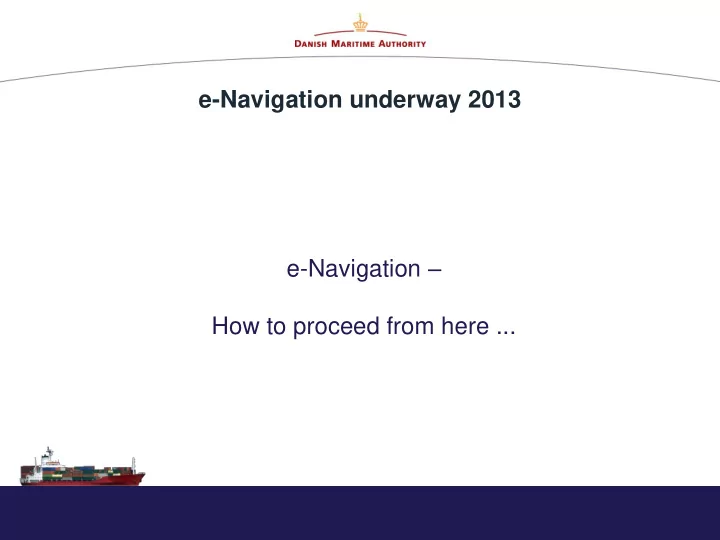

e-Navigation underway 2013 e-Navigation – How to proceed from here ...
The process up to this point • The idea behind the concept emerged around 2005 • A strategy for the development and implementation of e-Navigation was approved by MSC 85 (December 2008) • Subsequent work followed the process described in the strategy • The current overarching architecture and postponement of the target completion date of the Strategy Implementation Plan (SIP) from 2012 to 2014 was approved by MCS 90 (May 2012) • A final list of gaps was approved by NAV 58 (July 2012), and progress on the development of SIP was noted by MCS 91 (December 2012)
Where are we now? • Much material is available for use on the risk analysis (FSA) as well as on the Maritime Service Portfolio and e-Navigation solutions • Until now, the entire e-Navigation topic has progressed over a broad front • Is it feasible to continue developing all e-Navigation solutions simultaneously, or will this hamper progress due to ever increasing complexity?
The SIP and the way forward • There is a need to focus efforts • A roadmap for e-Navigation should be one of the main component of the Strategy Implementation Plan • The roadmap should - describe the initial steps of the implementation with a sufficient degree of detail to start implementation - outline the subsequent steps, providing a common understanding of where e- Navigation will eventually take us
We should remain ambitious E-navigation is as important as ever Focus our efforts without lowering the level of ambition Strive to achieve the goals and benefits defined in the e-navigation strategy from 2008
The essential elements of the initial step should be An e-navigation communication infrastructure enabling reliable and efficient sharing of maritime data ship-ship, ship-shore, shore-ship and shore-shore A few valuable e-navigation services that utilize/demonstrate the infrastructure
The initial services could be ... Services for promulgating and displaying MSI, demonstrating superiority over existing solutions (low hanging fruits) Services for navigation in polar waters, such as promulgation and display of ice charts or safe passages through ice Services for automated reporting to minimise the administrative burdens distracting the mariner from the act of navigation Services for automated collection and distribution of SAR information Services allowing navigators as well as VTS to detect other vessels’ intentions and critical situations at an earlier point in time by sharing vessels’ intended routes
Let’s not forget what we set out to do ... On board : Navigation systems that benefit from the integration of own ship sensors, supporting information, a standard user interface, and a comprehensive system for managing guard zones and alerts Ashore : The management of vessel traffic and related services from ashore enhanced through better provision, coordination, and exchange of comprehensive data in formats that will be more easily understood and utilized by shore-based operators in support of vessel safety and efficiency Communications : An infrastructure providing authorized seamless information transfer on board ship, between ships, between ship and shore and between shore authorities and other parties with many related benefits. From the vision of e-Navigation, MSC 85/26/Add.1, Annex 20
Thank you
Recommend
More recommend